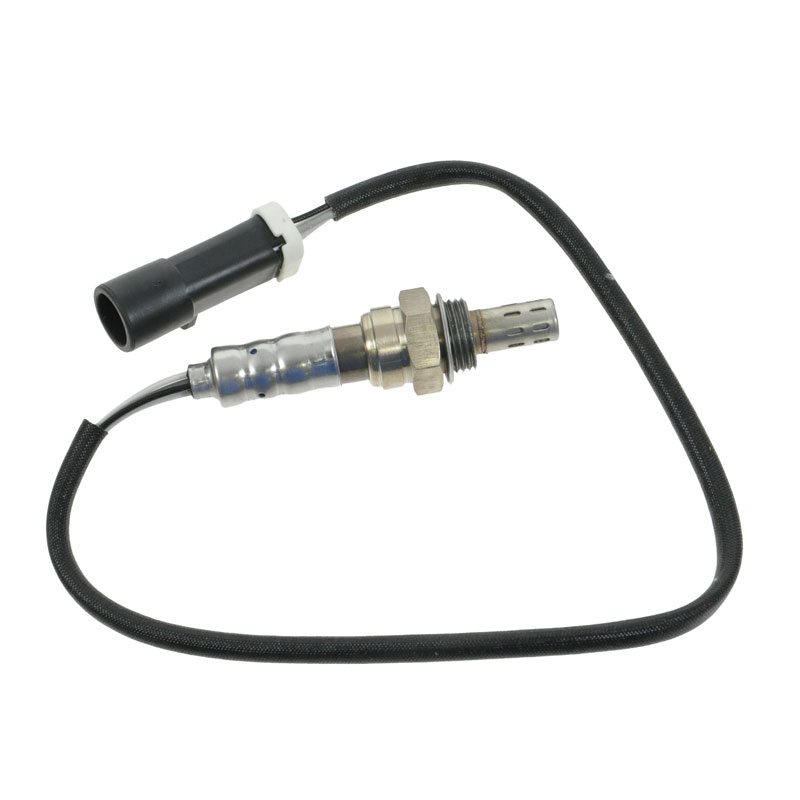What is an O2 Sensor?
What Is an O2 Sensor and What Does It Do?
An
oxygen (O2) sensor, also known as an air fuel ratio sensor, is a device that
gauges the ratio of fuel-to-air that the engine is receiving by measuring the
amount of oxygen in the exhaust. It then feeds this information to an on-board
computer known as the Engine Control Unit (ECU). The ECU adjusts the
amount of fuel supplied to the engine. This is to avoid having a mixture that's
either "rich," with too much fuel, or "lean," with too little fuel. Problems
with the oxygen sensor can affect your fuel efficiency and your vehicle's
emissions and keep
 your engine from running smoothly.
your engine from running smoothly.
The purpose of the oxygen sensors is to get the engine running as closely as possible to what engineers call stoichiometric combustion or theoretical combustion, in which fuel is burned completely. For gasoline, this is an air-to-fuel ratio of about 14.7:1. Chemists and engineers use the Greek letter Lambda to designate the stochiometric ratio. For this reason, oxygen sensors are sometimes called lambda sensors.
The oxygen sensor determines the air-to-fuel ratio through a chemical process that we'll only cover briefly here. Part of the O2 sensor resides inside the vehicle's exhaust system. The other part is outside the vehicle in the open air. The sensor is coated with platinum, which reacts with oxygen to produce an electrical charge. The difference in charge between the inside and outside creates a voltage. That voltage carries up the wire to the ECU, which uses that info to determine the air fuel ratio and how to adjust the fuel input.
Volvo introduced automotive oxygen sensors in 1976, but they became essentially necessary in the United States in the early 1980s, with changes to the Clean Air Act. In the mid-1990s, the Clean Air Act was updated again, making additional sensors necessary. Today many cars and trucks may have as many as four O2 sensors.
How Many O2 Sensors Are There and Where Are They Located?
Since 1981, most vehicles have been manufactured with one oxygen sensor per bank of cylinders. That's one on an inline engine and two on a V-shaped engine. The banks may be named as "left" and "right" or "front" and "rear" depending on how the engine is mounted in the engine bay.
These are located in the exhaust manifold or the exhaust pipe and are now known as "upstream" or "pre-cat" sensors, since they are located before the catalytic converter.
With new emission standards, vehicles from about 1996 forward also generally have sensors after the catalytic converter now known as "downstream" or "post-cat" sensors. Some cars with single bank engines may have two sensors in each position.
In general, recent car and truck models will have one upstream and one downstream sensor per bank, totaling either two or four O2 sensors.
Different Types of O2 Sensors
It's not quite so simple, we're sorry to say. In addition to being upstream or downstream and for one bank or the other, oxygen sensors may be narrowband or wideband. Narrowband sensors only measure if the air fuel mixture is rich, lean, or stoichiometric. The ECU must keep making small adjustments to strike the correct balance on average. A wideband sensor can make an accurate measurement of what the air fuel ratio actually is, allowing the ECU to more precisely adjust the air fuel mixture. This results in better performance and fuel economy as well as better emissions.
The number of wires in a sensor is also significant. Many early O2 sensors only used one or two wires. More recent examples will include at least three wires, with one functioning to heat the oxygen sensor. The oxygen sensor works best at a temperature of about 650 degrees Fahrenheit. Until the sensor warms up to that temperature, the ECU runs in open loop mode, where it essentially guesses what the correct fuel mix should be. When the sensor is running, there is a closed feedback loop where the ECU responds to the information to the sensor, and the sensor responds to the fuel mix dictated by the ECU. Heating the sensor allows this closed loop mode to take effect sooner, making the engine more efficient more of the time.
Oxygen sensors may also be sold as a direct fit, which will plug into a harness on the vehicle's chassis or as universal pieces which must be spliced and soldered into place. The former will obviously be easier to replace.
How Do Oxygen Sensors Fail?
Oxygen sensors have to exist in a pretty rough environment. The sensor itself is partly inside the very hot exhaust stream and is exposed to any number of different combustion byproducts. The rest of the sensor hangs out below the vehicle where it is exposed to all kinds of dirt and debris. It's no wonder that things occasionally go wrong. The sensor itself can become clogged with particulate matter or corroded by the various chemicals it encounters. The outside parts can be damaged by abrasive dirt and rocks.
What Are the Symptoms of a Bad Oxygen Sensor?
Some signs of a bad oxygen sensor are subtle, but oxygen sensors can be checked for failure with a digital voltmeter.
Reduced Miles Per Gallon (mpg)
A failing oxygen sensor can keep a car or truck's engine from running at maximum efficiency. This can lead to reduced gas mileage and worse emissions, and these effects may be hard to notice. Unless you are absolutely scrupulous about recording your miles per gallon, you might not notice a change in your fuel usage.
Failed Car Inspection
The first sign that your emissions are bad will probably be a failed car inspection. There are some subtle signs that the oxygen sensors are not functioning correctly, and this why it's common to learn of a failing oxygen sensor during an inspection.
Rough Idling or Engine Knock / Pinging from Disrupted Engine Timing
Faulty oxygen sensors may lead to disrupted engine timing, which can cause some subtle signs such as rough idling and engine knock or pinging.
Check Engine Light
There is one rather obvious sign of a faulty oxygen sensor: the check engine light. Your oxygen sensor is the most likely culprit when the check engine light comes on.
Can I Replace an Oxygen Sensor Myself?
Replacing an oxygen sensor is doable with some effort. Because of the extreme heat in the exhaust, the sensor can become seized—practically welded—into place. If that's the case, it may require extra effort to remove. The new sensor may come with some anti-seize grip that you can apply around the threading to keep that from happening next time. Be sure not to get any grease onto the sensor itself or it may not work properly.
In fact, overall, you want to be very careful with the new oxygen sensor since anything that gets on it or in it may impede its proper functioning. As mentioned before, universal sensors will take more time to install since they must be spliced to the vehicle's wiring instead of plugging in directly.
Need an Oxygen Sensor Replacement?

If you are in need of an oxygen sensor replacement, you have come to the right place. 1A Auto not only knows everything about car and truck O2 sensors, but we stock the highest quality, most dependable aftermarket oxygen sensors available. We carry upstream and downstream oxygen sensors—and much more—for many cars, trucks, vans and SUVs, and at great prices!

